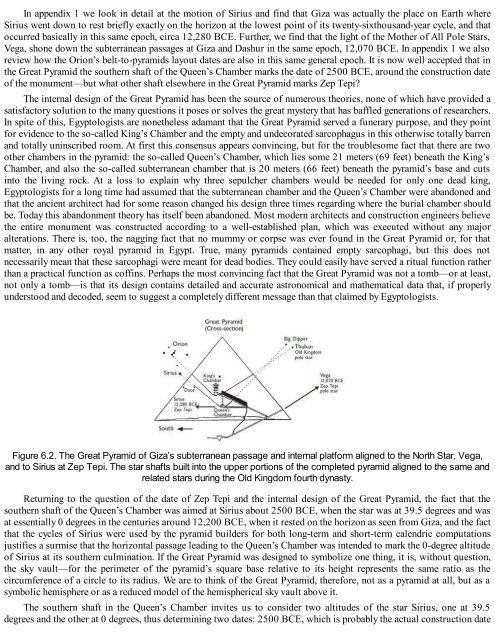Black Genesis: The Prehistoric Origins of Ancient Egypt
Black Genesis: The Prehistoric Origins of Ancient Egypt
Black Genesis: The Prehistoric Origins of Ancient Egypt
You also want an ePaper? Increase the reach of your titles
YUMPU automatically turns print PDFs into web optimized ePapers that Google loves.
In appendix 1 we look in detail at the motion <strong>of</strong> Sirius and find that Giza was actually the place on Earth where<br />
Sirius went down to rest briefly exactly on the horizon at the lowest point <strong>of</strong> its twenty-sixthousand-year cycle, and that<br />
occurred basically in this same epoch, circa 12,280 BCE. Further, we find that the light <strong>of</strong> the Mother <strong>of</strong> All Pole Stars,<br />
Vega, shone down the subterranean passages at Giza and Dashur in the same epoch, 12,070 BCE. In appendix 1 we also<br />
review how the Orion’s belt-to-pyramids layout dates are also in this same general epoch. It is now well accepted that in<br />
the Great Pyramid the southern shaft <strong>of</strong> the Queen’s Chamber marks the date <strong>of</strong> 2500 BCE, around the construction date<br />
<strong>of</strong> the monument—but what other shaft elsewhere in the Great Pyramid marks Zep Tepi?<br />
<strong>The</strong> internal design <strong>of</strong> the Great Pyramid has been the source <strong>of</strong> numerous theories, none <strong>of</strong> which have provided a<br />
satisfactory solution to the many questions it poses or solves the great mystery that has baffled generations <strong>of</strong> researchers.<br />
In spite <strong>of</strong> this, <strong>Egypt</strong>ologists are nonetheless adamant that the Great Pyramid served a funerary purpose, and they point<br />
for evidence to the so-called King’s Chamber and the empty and undecorated sarcophagus in this otherwise totally barren<br />
and totally uninscribed room. At first this consensus appears convincing, but for the troublesome fact that there are two<br />
other chambers in the pyramid: the so-called Queen’s Chamber, which lies some 21 meters (69 feet) beneath the King’s<br />
Chamber, and also the so-called subterranean chamber that is 20 meters (66 feet) beneath the pyramid’s base and cuts<br />
into the living rock. At a loss to explain why three sepulcher chambers would be needed for only one dead king,<br />
<strong>Egypt</strong>ologists for a long time had assumed that the subterranean chamber and the Queen’s Chamber were abandoned and<br />
that the ancient architect had for some reason changed his design three times regarding where the burial chamber should<br />
be. Today this abandonment theory has itself been abandoned. Most modern architects and construction engineers believe<br />
the entire monument was constructed according to a well-established plan, which was executed without any major<br />
alterations. <strong>The</strong>re is, too, the nagging fact that no mummy or corpse was ever found in the Great Pyramid or, for that<br />
matter, in any other royal pyramid in <strong>Egypt</strong>. True, many pyramids contained empty sarcophagi, but this does not<br />
necessarily mean that these sarcophagi were meant for dead bodies. <strong>The</strong>y could easily have served a ritual function rather<br />
than a practical function as c<strong>of</strong>fins. Perhaps the most convincing fact that the Great Pyramid was not a tomb—or at least,<br />
not only a tomb—is that its design contains detailed and accurate astronomical and mathematical data that, if properly<br />
understood and decoded, seem to suggest a completely different message than that claimed by <strong>Egypt</strong>ologists.<br />
Figure 6.2. <strong>The</strong> Great Pyramid <strong>of</strong> Giza’s subterranean passage and internal platform aligned to the North Star, Vega,<br />
and to Sirius at Zep Tepi. <strong>The</strong> star shafts built into the upper portions <strong>of</strong> the completed pyramid aligned to the same and<br />
related stars during the Old Kingdom fourth dynasty.<br />
Returning to the question <strong>of</strong> the date <strong>of</strong> Zep Tepi and the internal design <strong>of</strong> the Great Pyramid, the fact that the<br />
southern shaft <strong>of</strong> the Queen’s Chamber was aimed at Sirius about 2500 BCE, when the star was at 39.5 degrees and was<br />
at essentially 0 degrees in the centuries around 12,200 BCE, when it rested on the horizon as seen from Giza, and the fact<br />
that the cycles <strong>of</strong> Sirius were used by the pyramid builders for both long-term and short-term calendric computations<br />
justifies a surmise that the horizontal passage leading to the Queen’s Chamber was intended to mark the 0-degree altitude<br />
<strong>of</strong> Sirius at its southern culmination. If the Great Pyramid was designed to symbolize one thing, it is, without question,<br />
the sky vault—for the perimeter <strong>of</strong> the pyramid’s square base relative to its height represents the same ratio as the<br />
circumference <strong>of</strong> a circle to its radius. We are to think <strong>of</strong> the Great Pyramid, therefore, not as a pyramid at all, but as a<br />
symbolic hemisphere or as a reduced model <strong>of</strong> the hemispherical sky vault above it.<br />
<strong>The</strong> southern shaft in the Queen’s Chamber invites us to consider two altitudes <strong>of</strong> the star Sirius, one at 39.5<br />
degrees and the other at 0 degrees, thus determining two dates: 2500 BCE, which is probably the actual construction date


